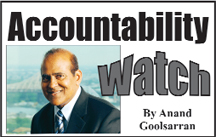 The Auditor General completed his audit of the Government’s accounts for the year ended 31 December 2017. He presented his report on 28 September 2018 to the Speaker of the National Assembly who laid in the Assembly on 18 October 2018. Since then, the media has been highlighting various aspects of the report.
The Auditor General completed his audit of the Government’s accounts for the year ended 31 December 2017. He presented his report on 28 September 2018 to the Speaker of the National Assembly who laid in the Assembly on 18 October 2018. Since then, the media has been highlighting various aspects of the report.
The Public Accounts in Perspective
Article 223 of the Constitution defines the public accounts to include the accounts of: (i) all central and local government bodies and entities; (ii) all bodies and entities in which the State has a controlling interest; and (iii) all projects funded by way of loans and grants by a foreign State or organisation. Central and local government bodies include Ministries, Departments and Regions as well as the municipalities, the Neighbourhood Democratic Councils (NDCs), and district and village councils. On the other hand, entities in which controlling interest vests in the State include public corporations, government companies and statutory bodies, while foreign-funded projects are those of the World Bank and Inter-American Development Bank, among others.
The Auditor General is in effect the external auditor of the entire public sector. Given the enormity of his mandate, there is provision for the engagement of Chartered Accountants in public practice to audit on his behalf and under his supervision, any of the accounts referred to above. It has been the practice for the audits of public enterprises to be contracted out to Chartered Accountants because of their greater expertise in commercial-type audits.
The report for 2017, as in previous reports, covers Ministries, Departments and Regions only since the other entities – the six municipalities, the 65 Neighbourhood Democratic Councils, the 215 Amerindian Village Councils as well as the several foreign-funded projects – are required to have separate financial reporting and audit. This is because these entities are governed by separate legislation, such as the Public Corporations Act, the Companies Act, Municipal and District Councils’ Act, the Local Government Act and the Amerindian Act. Statutory bodies, such as the Bank of Guyana and the Guyana Revenue Authority, also have their own legislation. Foreign-funded projects are, however, the subject of separate agreements with the Government.
Given that the mandate of the Auditor General relates to the public accounts in their entirety, in principle, the audited accounts of these other entities should also be laid in the Assembly and referred to the Public Accounts Committee (PAC) for detailed examination. However, this is not being done. That apart, most of these entities are significantly in arrears in terms of financial reporting and audit, and some do not have audited financial statements since they were established. These include the NDCs and the Amerindian Village Councils. In the circumstances, one must not view the Auditor General’s report as having fully satisfied constitutional and legislative requirements relating to public accountability. This is an issue that should be discussed and resolved by the PAC.
The public accounts, as contained in the Auditor General’s report, comprises the consolidated financial statements of the Government and the accounts of Ministries Departments and Regions. The report is entitled “Report of the Auditor General on the Public Accounts of Guyana and the Accounts of Ministries/ Departments/Regions…” This title was framed during the finalization of the 1992 report because at that time the public accounts were considered the consolidated financial statements of the Government only. Given the constitutional amendment of 2001, it would be more appropriate for the report to be captioned “Report of the Auditor General on the Consolidated Financial Statements of the Government and the Accounts of Ministries, Departments and Regions…” One hopes that this amendment will be reflected in the Auditor General’s 2018 report.
Audit Opinion
The culmination of the work of an external auditor is the expression of an opinion on the financial statements of the organisation in terms of their fair presentation and compliance with applicable laws, regulations and circular instructions as well as adherence to any contractual obligations. The Auditor General is the external auditor of the Government. His 2017 report is contained in two volumes and covers 734 pages. However, the actual report is of 444 pages in length, while the remaining pages comprise the audited accounts. The report begins with the Auditor General’s opinion of the financial statements, followed by an executive summary, then the detailed findings and recommendations.
Of the ten sets of financial statements comprising the consolidated accounts, the Auditor General issued an unqualified opinion or a ‘clean bill of health’ on only two statements – Receipts and Payments of the Contingencies Fund; and Schedule of Issuance and Extinguishment of all Loans. He has also disclaimed his opinion on two other statements – the Deposits Fund; and the Statement of Current Assets and Liabilities of the Government – “because of the significance of the comments as contained in the relevant sections of my report” and his inability “to obtain sufficient appropriate audit evidence to provide a basis for an opinion on these statements.” For all the other statements and accounts, that is, the remaining six consolidated financial statements and the more than 200 capital and current expenditure appropriation accounts and revenue accounts of Ministries/Departments/Regions, the Auditor General has qualified his opinion because of the “effects of the matters which might have been shown to be necessary as a result of the observations contained in the relevant sections of my report”.
A review of the findings contained in these sections, however, suggests that not all of these accounts deserve to be qualified. For example, there were no adverse findings relating to the End of Year Outcome and Reconciliation Report; Statement of Expenditure Compared with the Estimates of Expenditure (both capital and current); and Expenditure in Respect of those Services which are a Direct Charge on the Consolidated Fund. The same could be said of several of the appropriation and revenue accounts of Ministries/Departments/Regions. This is an area in which the Audit Office needs to pay particular attention to when drafting its audit opinion.
Although the findings of the report were discussed with the Heads of Budget Agency, in keeping with normal practice the proposed opinions on the individual accounts should be discussed with them to enable them to appreciate the basis upon which the opinions were arrived at, and more importantly, to give Heads of Budget Agencies an opportunity before the report is issued to rectify any deficiency/deficiencies giving rise to any qualified opinion or a disclaimer of opinion as the case may be. One can appreciate the difficulty to capture in a sentence or two the audit opinion covering the more than 200 accounts with wide variability in terms of their fair presentation. However, a sincere effort needs to be made if the Audit Office is to ensure that its work is in full compliance with the International Standards on Auditing and other related standards.
One suggestion is to group the appropriation and revenue accounts into three categories depending on the results of the audit: those whose findings do not affect their fair presentation (unqualified opinion); those whose findings materially affect their fair presentation (qualified opinion); and those whose findings are so fundamental that an opinion as to their fair presentation cannot be given (disclaimer of opinion). This approach will facilitate the crafting of a more realistic opinion on the accounts. It will also represent an improvement compared with the past, including during my tenure.
Executive Summary
The following are the highlights of the report, as gleaned from this section and summarized in his own words by this writer:
Contract awards
(a) Overpayments totalling $71.738 million were made on 79 contracts based on measured works at the time of the audit, of which amounts totalling $50.461 million remained unrecovered at the time of reporting;
(b) There were breaches in the Procurement Act in relation to the award of contracts in Regions 5 and 6 where restricted tendering was used instead of adherence to competitive bidding procedures;
(c) A Region 10 contractor received an advance payment of $39 million. However, at the time of reporting, no works had commenced, and the site was abandoned. The same contractor received another advance payment from the Ministry of Public Infrastructure but no “significant” work had commenced; and
(d) There has been a continuation of the practice of drawing cheques at the end of the year to pay contractors although the works had not been completed. This is a breach of the Fiscal Management and Accountability Act which requires all unutilised balances to be returned to the Treasury.
Unpresented Payment Vouchers
A total of 599 payment vouchers valued $528.375 million were not presented for audit, of which 387 valued $426.643 million relates to Region 1 and the Ministry of Indigenous Peoples’ Affairs;
Cheque Order Payments
Several Ministries, Departments and Regions failed to clear cheque order payments (i.e. payments in advance of the receipt of goods/services) within the stipulated time-frame through the submission of bills and receipt in support of the related expenditure. At the time of reporting, a total of 2,140 cheque orders valued at $1.710 billion remained outstanding, 1,415 of which valued at $1.060 billion relates to prior periods. In the circumstances, it could not be determined whether value was received in respect of these payments.
Drugs and Medical Supplies
The Ministry of Public Health acquired drugs and medical supplies for the ten Regions and received amounts totalling $1.789 billion. Of this sum, amounts totalling $1.747 billion were shown as having been expended. Although there was evidence that the items were received by the Regions, the related costs were not reflected in the documentation. As a result, it could not be determined whether the Regions received full value for the amounts expended. The Audit Office noted that three amounts totalling $144.098 million were refunded to the Treasury in January and March 2018. These amounts should have been refunded to the Treasury before the close of the year.
Staffing shortages in the Regions
There were 323 vacancies that were advertised for the Regions, including key positions such as Regional Health Officer, Regional Education Officer, Chief Accountants, Accountants, Senior Personnel Officers and Procurement Officers. The Audit Office was of the view that the vacancies would have an adverse effect on the operations of the Regions and in particular the level of control needed to ensure adequate checks and balances.
Forensic Audits
(a) The sum of $500 million was shown as having been expended on D”urban Park rehabilitation project. This amount was used to make payments to Homestretch Development Inc. (HDI), a private company that was established to oversee the works. However, the only documents attached to the payment vouchers were the list of HDI’s creditors and proposed payment allocation;
(b) There were eight contracts awarded by Region 6 Tender Board where the bills of quantities and the contract sums were identical to the Engineer’s Estimate. Four of these were awarded on the same day. These observations raise doubts as to whether there has been a circumvention of the tendering process;
(c) The Ministry of Communities received from the Ministry of Finance the sum of $400 million to pay contractors for sanitation services rendered to the Georgetown City Council. However, details of the payments, including the exact periods and description/particulars of services, and its related costs, were not provided. Instead, a summary by contractor and nature of indebtedness was attached to the payment vouchers; and
(d) In relation to the supply of dietary items for the Kato Breakfast School in Region 8, a total of 60 payments totalling $33.663M were made to a supplier. However, prices for items purchased were higher than those of similar items purchased by the Region from other suppliers.
Guyana Revenue Authority
Only 17 percent, or 18,351 of the 105,522 self-employed persons, filed Income Tax Returns. The total amount received was a mere $4.9 million.
Non-Delivery of Items
At the time of reporting, items valued $437.033M for which payments were made, were not delivered. Of this amount, $193.368 million relates to the acquisition of: (i) drugs and medical supplies, three ambulances, one canter truck and equipment for the Ministry of Public Health; and (ii) a multi-purpose fire rescue boat, an automated finger-print identification system, furniture and equipment for the Ministry of Public Security.
Employment Costs
The actual staffing of nine Regions exceeded their approved allocations by 814. However, actual expenditure was $258.499 million less than the amount allocated.
Shortfall in Capital Expenditure
There was a shortfall of $9.202 billion in capital expenditure, attributable mainly to the low execution rate of major foreign-funded projects.
Status of Implementation of Recommendations
A total of 602 recommendations were made in 2016 of which 178 or 30 percent were partially implemented, while 174 or 28 percent were not implemented. This means that after one year, only 42 percent of the recommendations were fully implemented.









